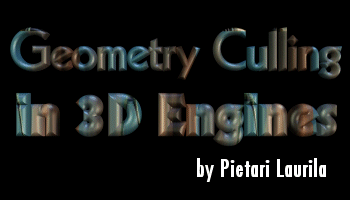11/10 - 11/12 @ Montréal, Canada
12/5 - 12/7 @ Shanghai, China
12/24 - 12/27
2/28 - 3/4 @ San Francisco, CA
More events...
2406 articles in the reference section.
Help us fight cancer!
Join SETI Team GDNet!

|
PVS-based arbitrary geometry occlusion cullingRecently, PVS-based occlusion culling algorithms for more general environments have been proposed. These algorithms follow the PVS principle in that they try to find a tight overestimation of the true PVS for a given viewcell. The algorithm by Schaufler et. al. [SDDS00] first discretizes the scene by building an octree containing empty, boundary and opaque nodes. Then, they find opaque (solid) octree nodes, and, for all viewnodes, check what portion of space the node definitely occludes with respect to any position in the viewnode. Only the nodes not hidden are inserted into the PVS for the viewcell node. The approach is also well suited for finding the definitely hidden parts of terrain in terrain rendering. An alternative algorithm to the problem by Durand et. al. [DDTP00] introduces something called extended projections to find the PVS for viewing cells. Both the presented algorithms, unlike some earlier ones, can handle occluder fusion; this means that two or more occluders can hide an object even if none of them could hide it alone. As the trend from Quake-like towards arbitrary geometry environments continues, these kind of algorithms will probably gain more and more widespread acceptance. Like PVS algorithms in general, these algorithms are only suited for mostly static environments. At this point, however, it is unclear what the real value of the presented algorithms for high-performance game environments is, as no engine I know of has implemented them. |
|||||||||||
|
|
|||||||||||